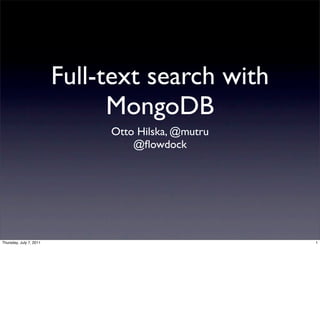The document outlines the development and implementation of a full-text search feature in Flowdock using MongoDB. It discusses the architectural choices made, the challenges faced with indexing and search performance, and the migration from PostgreSQL to MongoDB for handling diverse data formats. Additionally, it highlights the use of SSDs for improved performance and the simplicity of the implemented search system, which meets user needs without requiring complex features.










![{
"_id":ObjectId("4de92cd0097580e29ca5b6c2"),
"id":NumberLong(45967),
"app":"chat",
"flow":"demo:demoflow",
"event":"comment",
"sent":NumberLong("1307126992832"),
"attachments":[
],
"_keywords":[
"good",
"point", ...
],
"uuid":"hC4-09hFcULvCyiU",
"user":"1",
"content":{
"text":"Good point, I'll mark it as deprecated.",
"title":"Updated JIRA integration API"
},
"tags":[
"influx:45958"
]
}
Thursday, July 7, 2011 7
This is how a typical message looks like.](https://image.slidesharecdn.com/flowdockfulltextmongodbweb-110707060851-phpapp02/85/Flowdock-s-full-text-search-with-MongoDB-11-320.jpg)



![db.messages.ensureIndex({flow: 1, tags: 1, id: -1});
db.messages.find({flow: 123,
tags: {$all: [“production”]})
.sort({id: -1});
Thursday, July 7, 2011 9
One of the key features in Flowdock is tagging. For example, if I’m doing some changes to
our production environment, I mention it in the chat and tag it as #production. Production
deployments are automatically tagged with the same tag, so I can easily get a log of
everything that’s happened.
It’s very easy to implement with MongoDB, since we just index the “tags” array and search
using it.](https://image.slidesharecdn.com/flowdockfulltextmongodbweb-110707060851-phpapp02/85/Flowdock-s-full-text-search-with-MongoDB-15-320.jpg)







![“Good point. I’ll mark it as deprecated.”
_keywords: [“good”, “point”, “mark”, “deprecated”]
Thursday, July 7, 2011 16
You need client-side code for this transformation.
What’s possible: stemming, search by beginning of the word
What’s not possible: intelligent ranking on the DB side (which is ok for us, since we want to
sort results by time anyway)](https://image.slidesharecdn.com/flowdockfulltextmongodbweb-110707060851-phpapp02/85/Flowdock-s-full-text-search-with-MongoDB-23-320.jpg)

![db.messages.find({
flow: 123,
_keywords: {
$all: [“hello”, “world”]}
}).sort({id: -1});
Thursday, July 7, 2011 18
Search is also trivial to implement. As said, our users want the messages in chronological
order, which makes this a lot easier.](https://image.slidesharecdn.com/flowdockfulltextmongodbweb-110707060851-phpapp02/85/Flowdock-s-full-text-search-with-MongoDB-25-320.jpg)





















